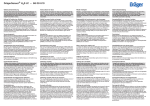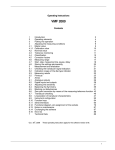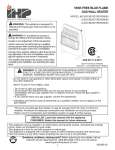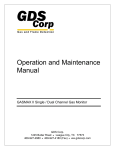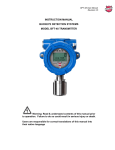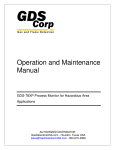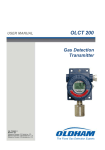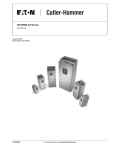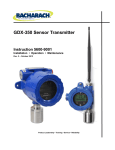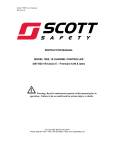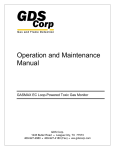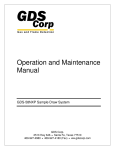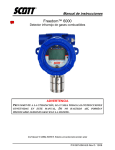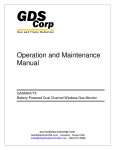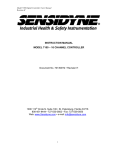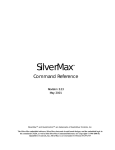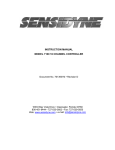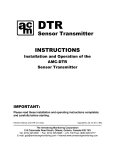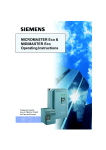Download GDS TRANSMAX EC User Manual
Transcript
TRANSMAX Gas Monitor Instruction Manual Revision 1.0 Operation & Maintenance Manual TRANSMAX Product Family TRANSMAX / EC Toxic / Oxygen Loop-Powered Gas Monitor for Non-hazardous Locations TRANSMAX II Single or Dual Powered Gas Monitor for Non-Hazardous Locations Important: Read and understand contents of this instruction manual prior to use. Improper use of equipment could result in instrument malfunction or serious injury. AUTHORIZED DISTRIBUTOR: GasDetectorsUSA.com Houston, Texas USA [email protected] 832-615-3588 TRANSMAX Gas Monitor Instruction Manual Revision 1.0 WARRANTY GDS Corp warrants the TRANSMAX Gas Monitor to be free from defects in workmanship and materials under normal use for a period of two (2) years from the date of shipment. Final determination of the nature of and responsibility for defective equipment will be made by GDS Corp personnel. Defective or damaged equipment must be shipped prepaid to GDS Corp or the factory representative from which it shipped originally. In all cases this warranty is limited to the cost of the equipment supplied by GDS Corp. The customer will assume all responsibility for the misuse of this equipment by its employees or other personnel. All warranties are contingent upon correct use in the application for which the product is designed and do not cover products which have been modified or repaired without GDS Corp approval, or which have been subject to neglect, accident, improper installation or application, or on which the original identification marks have been removed or altered. Except for the express warranty written above, GDS Corp disclaims all warranties with regard to products sold, including all implied warranties of merchantability or fitness. IMPORTANT SAFETY INFORMATION Users should have a detailed understanding of TRANSMAX Gas Monitor operating and maintenance instructions. Use the TRANSMAX Gas Monitor only as specified in this manual or detection of gases and the resulting protection provided may be impaired. Read the following WARNINGS prior to use. • Calibrate with known target gas at start-up and check on a regular schedule, at least every 90 days. More frequent inspections are encouraged to spot problems such as dirt, oil, paint, grease or other foreign materials on the sensor head. • Do not paint the sensor assembly or transmitter. • Do not use the TRANSMAX Gas Monitor if its enclosure is damaged or cracked or has missing components. • Make sure the cover, internal PCB’s and field wiring are securely in place before operation. • Use only a replacement sensor assembly compatible with the TRANSMAX Gas Monitor and approved by GDS Corp. • Periodically test for correct operation of the system’s alarm events by exposing the monitor to a targeted gas concentration above the High Alarm set point. • Do not expose the TRANSMAX Gas Monitor to electrical shock or continuous severe mechanical shock. 2 TRANSMAX Gas Monitor Instruction Manual Revision 1.0 • Protect the TRANSMAX Gas Monitor from dripping liquids and high power sprays. • Use only for applications described within this manual. CAUTION: FOR SAFETY REASONS THIS EQUIPMENT MUST BE OPERATED AND SERVICED BY QUALIFIED PERSONNEL ONLY. READ AND UNDERSTAND INSTRUCTION MANUAL COMPLETELY BEFORE OPERATING OR SERVICING. ATTENTION: POUR DES RAISONS DE SÉCURITÉ, CET ÉQUIPEMENT DOIT ÊTRE UTILISÉ, ENTRETENU ET RÉPARÉ UNIQUEMENT PAR UN PERSONNEL QUALIFIÉ. ÉTUDIER LE MANUE D’INSTRUCTIONS EN ENTIER AVANT D’UTILISER, D’ENTRETENIR OU DE RÉPARER L’ÉQUIPEMENT. GDS Corp Contact Information GDS Corp is always interested in receiving feedback on our products and services. If you wish to contact GDS Corp for any reason the contact information is shown below: GDS Corp 2513 Hwy 646 Santa Fe, Texas 77510 USA (409) 927-2980 (409) 927-4180 (Fax) [email protected] [email protected] www.gdscorp.com 3 TRANSMAX Gas Monitor Instruction Manual Revision 1.0 This Page Intentionally Left Blank 4 TRANSMAX Gas Monitor Instruction Manual Revision 1.0 Table of Contents WARRANTY ...................................................................................... 2 IMPORTANT SAFETY INFORMATION............................................. 2 GDS Corp Contact Information ....................................................... 3 1.0 Introduction................................................................................. 7 1.1 TRANSMAX Family Overview..................................................................................... 7 1.2 TRANSMAX / EC Two-Wire Gas Monitor................................................................... 7 1.3 TRANSMAX II Three-Wire Gas Monitor ..................................................................... 7 1.4 TRANSMAX Features & Benefits ............................................................................... 8 1.5 TRANSMAX Available Sensors .................................................................................. 8 2.0 Specifications ............................................................................. 9 2.1 General Specifications................................................................................................ 9 2.2 Mechanical Specifications.......................................................................................... 9 2.3 Electrical Specifications (TRANSMAX /EC) ............................................................ 10 2.4 Electrical Specifications (TRANSMAX II) ................................................................ 10 2.5 Environmental Specifications .................................................................................. 10 3.0 General Operation .................................................................... 11 3.1 Electrochemical Sensors.......................................................................................... 11 3.2 Bridge-Type Sensors ................................................................................................ 11 3.3 Direct 4-20mA Input................................................................................................... 11 4.0 Installation & Initial Setup........................................................ 12 4.0 Unpacking & Setup.................................................................................................... 12 4.2 Location Considerations .......................................................................................... 12 4.3 Mounting & Orientation............................................................................................. 12 4.4 TRANSMAX / EC Wiring ............................................................................................ 13 4.5 TRANSMAX II Wiring ................................................................................................. 14 4.6 TRANSMAX II Alarm / MODBUS Board ................................................................... 15 4.7 TRANSMAX II Isolated 4-20mA Output Board ........................................................ 16 4.8 Initial Checkout & Calibration .................................................................................. 17 5 TRANSMAX Gas Monitor Instruction Manual Revision 1.0 5.0 General Operation .................................................................... 18 5.1 User Interface............................................................................................................. 18 5.1 Display Modes (“NEXT” key).................................................................................... 18 5.2 Alarm Indication ........................................................................................................ 18 5.3 Calibration (“DOWN / CAL” Key) ............................................................................. 19 5.4 System Configuration Menu (“EDIT” Key).............................................................. 21 5.5 System Configuration Page ..................................................................................... 22 5.5 Alarm Settings Page.................................................................................................. 23 5.6 Relay Configuration: ................................................................................................. 24 5.7 Sensor Information: .................................................................................................. 24 5.8 CLOCK / DELAY SETUP............................................................................................ 25 5.9 LCD Contrast Adjustments ...................................................................................... 26 5.10 HELP Screen .............................................................................................................. 26 5.11 Diagnostics ................................................................................................................ 26 5.12 RS-485 / MODBUS SETUP ........................................................................................ 26 5.13 MODBUS REGISTER AND FUNCTION CODE SUMMARY ..................................... 26 5.14 SYSTEM SECURITY................................................................................................... 26 6.0 Advanced Settings and Procedures ....................................... 27 6.1 Introduction................................................................................................................ 27 6.2 Transmitter Selection Menu ..................................................................................... 27 6.3 Electrochemical Sensor Installation Procedure..................................................... 28 6.4 Bridge-Style Sensor Installation Procedure ........................................................... 28 6.5 Technicians-Only Menu ............................................................................................ 29 APPENDIX 1 – MODBUS REGISTERS .......................................... 33 6 TRANSMAX Gas Monitor Instruction Manual Revision 1.0 1.0 Introduction 1.1 TRANSMAX Family Overview The TRANSMAX family of single and dual channel gas monitors is designed to provide continuous monitoring of hazardous gases in the workplace. Monitored values are displayed in numerically calibrated engineering units and bar graph format; 30-minute trend information is also instantly available. The TRANSMAX Gas Monitor can interface to standard GDS Corp electrochemical toxic or oxygen sensors, catalytic bead, infrared combustible or CO2 sensors, MOS solid-state sensors, millivolt, 0-10 volt or 4-20mA inputs. Advanced microcontroller-controlled electronics and easy-to-use LCD operator interface offers superior usability, diagnostics and fault analysis. For toxic or oxygen deficiency applications, the single channel TRANSMAX / EC TwoWire Loop-Powered Gas Monitor provides a calibrated 4-20 mA current sink signal for connection to control systems or other alarm instrumentation. Flashing LED indicators provide direct visual confirmation of hazardous conditions. Standard features include a real-time clock, event log, prompted calibration procedure and more. For combustible or CO2 applications, the dual channel-capable TRANSMAX II Gas Monitor offers a standard backlit display, optional local alarm relays and an RS-485 Modbus® interface or a pair of isolated 4-20mA outputs. The TRANSMAX II is capable of simultaneously monitoring a toxic sensor (Ch1) and a bridge-type sensor (Ch2) or two 4-20mA inputs. Dual channel units output two independent 4-20mA signals (current source). Non-volatile memory retains all configuration data during power interruptions and the calibration procedure can be easily performed by one person without opening the enclosure. Three separate alarm levels are available for each channel; these can be user-configurable for ‘alarm above’ or ‘alarm below’. 1.2 TRANSMAX / EC Two-Wire Gas Monitor In situations where low power electrochemical sensors for toxic or oxygen deficiency can be used, the loop-powered TRANSMAX / EC is most appropriate. All power needed for operation is extracted from the current loop; only two wires are needed and wire size may be smaller. The TRANSMAX / EC Display Assembly consumes less than 2.5 mA of quiescent current. CAUTION: It is important to understand that the receiver or controller device must supply the loop power for 2-wire operation. Be sure the receiver to be used supports this type of operation. 1.3 TRANSMAX II Three-Wire Gas Monitor The TRANSMAX II Gas Monitor is a single or dual-channel externally powered gas monitor for all toxic / oxygen depletion / combustible / CO2 applications. Certain options, including a back-lit display, local alarm relays and MODBUS interface are only available on the TRANSMAX II Gas Monitor. If the #10-0233 I/O Power Supply board is installed the unit is a TRANSMAX II Gas Monitor. 7 TRANSMAX Gas Monitor Instruction Manual Revision 1.0 1.4 TRANSMAX Features & Benefits ? Single or dual channel monitor for commercial and non-hazardous applications ? No potentiometer or jumper setting changes are ever required. All setup is done with menus accessed via the LCD / magnetic keypad operator interface without opening the enclosure. ? Field adjustable alarm levels may be alarm on high, alarm on low, fault, fail-safe, latching and acknowledgeable. ? New alarms cause front panel LED’s to flash (TM / EC) and become steady after acknowledge (TM II). ? Prompted CALIBRATION MODE advises when to apply gas during calibrations ? Thirty-minute trend screen shows rate of change of gas exposures ? Sensor life bar-graph updates after each SPAN calibration. ? Modular design affords efficient installation and setup 1.5 TRANSMAX Available Sensors The following sensors are generally available for the TRANSMAX family of gas monitors. For more information or for gases not shown, please contact GDS Corp. 10 Oxygen 21 Ozone 11 Carbon Monoxide 22 Ethylene Oxide 12 Chlorine 23 Arsine 13 Chlorine Dioxide 24 Silane 14 Hydrogen 25 Fluorine 15 Hydrogen Sulfide 26 Phosgene 16 Hydrogen Cyanide 27 Hydrazine 17 Hydrogen Chloride 28 Nitric Oxide 18 Hydrogen Fluoride 29 Nitrogen Dioxide 19 Sulfur Dioxide 30 Mercaptane TBM 20 Ammonia NH3 31 Tetrahydorthiophene 5x SmartIR Infrared Combustible and CO2 sensors 6x Photoionization Detectors for Volatile Organic Compounds 9x Catalytic Bead Combustible sensors 8 TRANSMAX Gas Monitor Instruction Manual Revision 1.0 2.0 Specifications 2.1 General Specifications Sensor Type: Electrochemical cell, bridge-type sensor or 4-20mA input Sensor Life: Varies by sensor and environmental conditions; sensors are guaranteed for one year in ambient monitoring applications Range: Varies by sensor; display capable of displaying 0 – 9999 with floating decimal point Display: Graphic LCD (240 x 128 pixel) shows value in engineering units; prompted calibration; highly detailed setup menu; technicians only menu for advanced features Accuracy: Typically ± 3% FS < 50% of range; ± 5% FS > 50% of range @ 35°C Configuration: Non-volatile solid state memory retains configuration values in the event of power outages Std Output: TRANSMAX / EC: Two-wire loop powered current sink TRANSMAX II: Single or dual channel 4-20mA current source TM II Options: Option Board #10-0233 with 3X Local 5A (resistive) Form C relays with MODBUS® interface. Relay 1 and Relay 2 level alarms are configurable for HIGH or LOW trip; normally energized (Failsafe) or normally de-energized; latching or non-latching. Relay 3 is always normally energized for failsafe operation so loss of power to the TRANSMAX GAS MONITOR II will be indicated as a “FAULT” condition. CAUTION: Relays are rated for RESISTIVE loads. Inductive loads, such contactor coils or motors may cause contact arcing, which emits RFI into the sensor signals. Use appropriate snubbers and MOV’s across inductive loads and keep relay wiring away from signal wires. 2.2 Mechanical Specifications Length: 4.8” (122 mm) Width: 4.7” (120 mm) Height: 3.7” (95 mm) Enclosure: Polycarbonate with polyurethane gasket; stainless steel screws Rating: NEMA 4X; IP66/67 ingress protection 9 TRANSMAX Gas Monitor Instruction Manual Revision 1.0 2.3 Electrical Specifications (TRANSMAX /EC) Voltage: 10 to 30 volts DC Power: Less than 0.75W in two-wire configuration Input: Accepts micro-amp signals from GDS Corp toxic / oxygen sensors Output: 4-20mA current sink, two wire, non-polarized Loop R: 650 ohms maximum in 2-wire mode 2.4 Electrical Specifications (TRANSMAX II) Voltage: 10 to 30 volts DC Power: Depends on sensor; typically less than 3W at 24VDC Input: Accepts micro-amp signals from GDS Corp toxic / oxygen sensors (Echem channel) and bridge-style signals from GDS Corp CO2, infrared and catalytic bead sensors. Also accepts 4-20mA input from three-wire remote sensors Output: Single or dual 4-20mA current source (three-wire); Optional dual isolated 4-20mA output available; Optional three form-C relay / MODBUS output. 2.5 Environmental Specifications Operating Temperature Range: -20°C to +50°C Typical Operating Range Operating Humidity Range: 5% to 99% Relative Humidity (non-condensing) Flammability: UL 94 5V (UL 746 C 5) UV Resistance: UL 508 10 TRANSMAX Gas Monitor Instruction Manual Revision 1.0 3.0 General Operation 3.1 Electrochemical Sensors Electrochemical sensors consist of electrodes separated by a thin layer of electrolyte with an opening to allow gas to enter. Gas diffusing into the sensor is either oxidized or reduced at the sensing electrode and generates a positive or negative electrical current proportional to the concentration of target gas present. Electrochemical sensors are typically used for toxic or oxygen measurement. The TRANSMAX / EC and TRANSMAX II (Channel 1 only) electrochemical inputs provide the signal conditioning circuitry necessary to process and measure this extremely low level input current. 3.2 Bridge-Type Sensors Cat-bead sensors consist of a matched pair of reference and analytical ceramic beads. The analytical bead is a tiny wire coil embedded within a bead of catalytic material. The reference bead is similar, except it does not contain catalytic material. Both beads operate in a bridge circuit that produces an output if the resistance of the analytical differs from that of the reference. The bridge is supplied with a constant voltage that heats the elements to approximately 550°C. Combustible gases are oxidized on the detector element, producing a signal proportional to the concentration of combustible gas. The reference tracks changes in temperature, pressure and humidity, which affect both elements equally. Infrared sensors operate on the principle that hydrocarbon gases absorb specific wavelengths of infrared light. Infrared LEL sensors are comprised of an infrared light source, light path and detector. Two wavelengths of light are compared, one that is absorbed by hydrocarbons, and one selected as a reference. The presence of hydrocarbon molecules reduces the intensity of the measurement beam and indicates the presence of combustible gas. The TRANSMAX II (Channel 2 only) bridge sensor input provides the signal conditioning circuitry necessary to process and measure this extremely low level input current. 3.3 Direct 4-20mA Input The TRANSMAX II Gas Monitor can be configured to accept direct 4-20mA input signals through either Channel 1 or Channel 2. These input signals can be sourced from any device that outputs a 4-20mA analog signal, either calibrated or non-calibrated. An excellent companion to the TRANSMAX II in this configuration is the GDS-49, a remote sensor transmitter that converts low level electrochemical sensor output to noncalibrated 4-20mA current. 11 TRANSMAX Gas Monitor Instruction Manual Revision 1.0 4.0 Installation & Initial Setup 4.0 Unpacking & Setup Open the package carefully, check for damage and make sure all accessories listed on the packing slip are present. These should include (but are not limited to) magnetic wands, manuals and Quickstart guides. 4.2 Location Considerations Factors such as air movement, gas density in relation to air, emission sources and environmental variables should be taken into account when determining sensor location. Air movement by fans, prevailing winds and convection should be carefully evaluated to determine if a leak is more likely to raise gas levels in certain areas; when appropriate, sensors should be placed next to valves, seals and other likely leak sources. Vapor density of a gas determines if it will rise or fall in air when there are no significant currents. Lighter than air gases should have the monitors mounted 12 – 18 inches (30 – 45 centimeters) above the potential gas leak and heavier than air gases should be this distance below. Even though the TRANSMAX Gas Monitor is designed for rugged service, sensors should be protected from environmental damage from water, snow, shock, vibration and dirt. 4.3 Mounting & Orientation The TRANSMAX Gas Monitor features a NEMA 4X rated polycarbonate enclosure with transparent removable cover. To remove the cover, unscrew the four stainless steel cover screws located at each corner. Modular design simplifies the installation of the TRANSMAX Gas Monitor. Once the cover is removed, the Display Assembly, mounted with captive thumbscrews is easily removed to allow access to field-wiring terminals. An optional 10-0234 Alarms & MODBUS board mounts piggyback to the back of the Display Assembly. If the unit is a TRANSMAX II, a 10-0233 I/O Power Supply board is mounted to the rear of the case assembly and connects to the Display Board via a short ribbon cable. WARNING: Qualified personnel should perform the installation according to applicable electrical codes, regulations and safety standards. Insure correct cabling and sealing fitting practices are implemented to maintain watertight integrity if mounted in an area where rain, water spray or moisture is present. WARNING: Do not install the sensor pointing upward. 12 TRANSMAX Gas Monitor Instruction Manual Revision 1.0 4.4 TRANSMAX / EC Wiring Unscrew the cover on the TRANSMAX / EC explosion-proof enclosure by removing the four stainless steel screws located at each corner. Loosen the 2 thumbscrews holding the display assembly in place and remove it. Electrochemical Sensor Wiring (EC Channel): The local electrochemical sensor connects to the TRANSMAX / EC display board via TB2 (SIMPLE EC SENSOR). Remote electrochemical sensors are not supported. Output Signal Wiring: The signal output wires connect to the TRANSMAX / EC display board via TB1 (2-WIRE 4-20mA Output). Maximum wiring size is #12 AWG. The distance 4-20 mA signals can travel is dependent upon several factors including the cable gauge, DC power supply voltage level and impedance of the input of the receiving device. Assuming a nominal 24 VDC power supply, maximum total loop resistance is 650 ohms in the 2-wire mode. Ground Wiring: It is highly recommended that the TRANSMAX / EC electronics be grounded to a low impedance earth ground. Connect a ground wire to the base plate located behind the TRANSMAX / EC display board. NOTE: Circuitry in the TRANSMAX / EC output automatically corrects for polarity so positive and negative are interchangeable. CAUTION: Applying +24VDC to any Sensor Input terminal may damage the TRANSMAX circuitry. FIGURE 1: TRANSMAX / EC DISPLAY BOARD 13 TRANSMAX Gas Monitor Instruction Manual Revision 1.0 4.5 TRANSMAX II Wiring Unscrew the cover on the TRANSMAX / EC enclosure by removing the four stainless steel screws located at each corner. Loosen the 2 thumbscrews holding the display assembly in place and remove it. A small ribbon cable is attached with sufficient length to allow access to the I/O Power Supply board mounted in the bottom of the enclosure. Electrochemical Sensor Wiring (Channel 1): The local electrochemical sensor connects to the TRANSMAX / EC display board via TB2 (SIMPLE EC SENSOR). Remote electrochemical sensors are not supported. Catalytic Bead / Bridge Sensor Wiring (Channel 2): A local or remote bridge-type sensor connects to the 10-0233 I/O Power Supply board via TB1. Output Signal Wiring: The 4-20mA signal output wires connect to the 10-0233 I/O Power Supply board display board via TB2. Maximum wiring size is #12 AWG. Plus 24VDC is connected to TB2-1 and power supply common is connected to TB2-4. A blocking diode protects the TRANSMAX if polarity of the power supply is reversed but it will not operate. The 4-20mA source current signal from the electrochemical sensor channel (if enabled) is available at TB2-2 and the 4-20mA signal from the bridge-style sensor channel (if enabled) is available at TB2-3. NOTE: The distance 4-20 mA signals can travel is dependent upon several factors including the cable gauge and DC power supply voltage level. Ground Wiring: It is highly recommended that the TRANSMAX / EC electronics be grounded to a low impedance earth ground. Connect a ground wire to the base plate located behind the TRANSMAX / EC display board. CAUTION: Applying +24VDC to either 4-20mA output terminal may damage the TRANSMAX circuitry. + TB2 = 3-wire xmtr; apply 9-30 VDC between PWR & GND. OUT 4-20’s source output. TB2-2=Toxic/O2 TB2-3=LEL C1 C2 + TP1 ST-48 I/O Power Supply Assy 10-0233 1 2 3 4 'CATBEAD' 1 TB1 = “Simple” catalytic bead sensor input. Sensor excitation volts between REF & ACT. S2 Ribbon to Display Assy. TB2 + C7 C8 TB1 1 + S1 S1 = “Smart” catalytic bead sensor input only FIGURE 2: TRANSMAX II I/O Power Supply Board 14 TRANSMAX Gas Monitor Instruction Manual Revision 1.0 4.6 TRANSMAX II Alarm / MODBUS Board The optional 10-0234 Alarm Relay / RS-485 Modbus board supplies two ALARM relays, a common FAULT relay and an RS-485 Modbus RTU slave port. This board is designed to connect to the back of the Display Assembly board. This option is only available for the TRANSMAX II three-wire powered unit. Relay Wiring: The two level alarm relays (Relay 1 and Relay 2)and the FAULT relay (Relay 3) provide Normally Open, Normally Closed and Common wiring contacts as shown. CAUTION: Alarm relays have dry contacts and power must be supplied from an external source. Contacts are rated for RESISTIVE loads! Inductive loads, such as contactor coils or motors, may cause contact arcing which shortens life and emits RFI into the sensor signals. Use appropriate arcing snubbers and MOV’s across inductive loads and keep wiring away from signal wires. External wiring to TB3 (Remote Alarm Reset) should be shielded and protected from noise spikes to prevent false Alarm Reset events from occurring Remote Alarm Reset TB3 P1 Assy: 10-0234 ST-48 Alarm / ModBus Option Relay 1 (K1) NO 1 C K1 2 NC 3 Relay 2 (K2) NO 4 C K2 5 NC 6 Relay 3 (K3) NO 7 C 8 K3 NC 9 TB1 1 A 2 B 3 S 4 A 5 B U1 J1 A (Installs RS-485 Terminating Resistor) B (Omits RS-485 Terminating Resistor) TB2 RS-485 ‘A’ & ‘B’ terminals are connected internally for easier IN / OUT cabling. ‘S’ is “no connect” for shield to continue. FIGURE 3: TRANSMAX II Alarm / MODBUS Board MODBUS Wiring: The RS-485 Modbus network should be wired as shown in Figure 27. Each TRANSMAX connected represents an RTU and must have a unique RTU address. RTU addresses are assigned in the MODBUS setup menu. Cabling must be a “daisy chain” as opposed to a “star” pattern for reliable operation. The “end of line” unit should have J1 installed in the ‘A’ position to enable the terminating resistor. All others should have J1 in the ‘B’ position. Front panel Rx / Tx LEDs are helpful troubleshooting 15 TRANSMAX Gas Monitor Instruction Manual Revision 1.0 tools.. RS-485 ModBus Master RS485 2-Wire Network A B Address 4 thru n DCS, PLC, PC, RC Systems ST-71 Controller Notes: TB2 TB2 TB3 TB3 TB1 Address 1 2. J1-A installs the terminating resistor & J1-B omits. Install TR only at “end of line” RTU. TB3 TB1 10-0234 ModBus/ Alarm Relay Option Board 1. Use Modbus setup menu to set each RTU to have a unique RTU address. TB2 3. TB2-1 connects to TB2-4 internally & TB2-2 connects to TB2-6 internally to simplify “arrive” / “depart” cabling. TB1 10-0234 ModBus/ Alarm Relay Option Board 10-0234 ModBus/ Alarm Relay Option Board Address 2 4. TB2-3 is “no connect” for cable shield continuation. Address 3 FIGURE 4: TRANSMAX II Alarm / MODBUS Board 4.7 TRANSMAX II Isolated 4-20mA Output Board Output Signal Wiring: The optional 10-0250 isolated 4-20mA Output Board provides dual 4-20mA outputs that are electrically isolated from sensor inputs and the 24 VDC power source. Each 4-20mA output share the same common terminal and are not isolated from each other. This board is installed behind the Display Assembly in the same location as the Relay / MODBUS board. Addition of this option is only available on the TRANSMAX II. P1 1/2A Isolated 4-20mA Output Option Assy: 10-0250 FUSE U8 1 - TB1 2 3 + 4 + - FIGURE 5: TRANSMAX II Isolated 4-20mA Output Board 16 TRANSMAX Gas Monitor Instruction Manual Revision 1.0 4.8 Initial Checkout & Calibration Apply power to the TRANSMAX and allow the unit to stabilize for at least one hour. Certain sensors may require additional time for warm-up. Monitor the display or 4-20mA output periodically to determine when the reading has stabilized. Although the unit has been calibrated at the factory prior to shipment, GDS Corp highly recommends the unit be calibrated after installation to ensure that no internal damage occurred during shipment and to ensure that the complete end-to-end system is operating properly. See Section 5.3 for a detailed step-by-step calibration procedure. If it is necessary to install a new sensor, see Section 6.3 or 6.4 for replacement sensor installation procedure. 17 TRANSMAX Gas Monitor Instruction Manual Revision 1.0 5.0 General Operation 5.1 User Interface The TRANSMAX interface uses four magnetic switches labeled “UP”, “DOWN”, “NEXT” and “EDIT” to provide access to all functions. These magnetic switches are arranged around the perimeter of the graphic display screen. A magnetic wand supplied with the TRANSMAX is needed to active the magnetic switches. To access the Configuration Menu during normal operation, activate the EDIT key while in any display mode. Use the UP and DOWN keys to select a specific item; to edit the entry activate the EDIT key and then use the UP or DOWN keys to modify the entry value. To save the changes and return to the previous menu, activate the NEXT key. CAUTION: The presence of a high intensity magnetic field may affect the operation of the TRANSMAX magnetic switches. 5.1 Display Modes (“NEXT” key) The TRANSMAX graphic display can be configured to show single channel or dual channel, values or trend information. To select a different display mode, select the NEXT key. Each swipe will cycle the display between Engineering Units and Trend display. Engrg. Units / Bar Graph ALM RST UP/ ALM1 ALM2 10 % LEL Measurement Name DOWN/CAL ALM RST UP/ ALM1 ALM2 NEXT FAIL Dual Channel Split Screen (Dual Sensor Mode Only) Engrg. Units / 30-Minute Trend FAIL ALM RST UP/ ALM1 ALM2 NEXT 10 % LEL RXD RXD RS485 TXD TXD DOWN/CAL NEXT A2 17.8 % O2 Def. A1 NEXT key toggles readout RS485 EDIT FAIL EDIT NEXT key toggles readout 0 % LEL DOWN/CAL RXD RS485 TXD EDIT Figure 6: Display Modes 5.2 Alarm Indication TRANSMAX gas monitors have front panel LED indicators for Alarm 1, Alarm 2 and Alarm 3 / Fault. Alarm levels can be set to any value within the assigned range, and can be configured for ALARM ABOVE or ALARM BELOW. The alarms can be LATCHED or non-latching and the On-Delay and Off-Delay values can be programmed via the System Configuration menu. 18 TRANSMAX Gas Monitor Instruction Manual Revision 1.0 NOTE: TRANSMAX gas monitor alarm indicators LEDs function with or without the presence of the Relay / MODBUS Output board. The TRANSMAX / EC alarm LEDs always flash to indicate an alarm condition, while the TRANSMAX II alarm LEDs initially flash and then become steady ON after an operator acknowledges the alarm by activating the UP/RESET key. NOTE: The “A3” alarm is typically dedicated to FAULT conditions indicating sensor failures or “out of measurement range” conditions. However, some applications require a third level alarm. The A3 menu is identical to A1 & A2 and may be set to trip at an upscale level value. A3 WILL ALSO TRIP WITH MISSING OR FAILED SENSORS REGARDLESS OF THE LEVEL VALUE! 5.3 Calibration (“DOWN / CAL” Key) Activating the DOWN / CAL key while in any display mode will cause the TRANSMAX to ask the user if a CALIBRATION is desired. If so, the EDIT key must then be pressed within 5 seconds or the previous display mode is reactivated. Calibration is the most important function to ensure correct operation of the TRANSMAX gas monitor. The CAL MODE is designed to make calibration quick, easy and error-free. A successful ZERO and SPAN calibration requires only four keystrokes. The 4-20mA output transmits 3mA during CAL MODE and 4mA during the subsequent CAL PURGE delay to prevent external alarms during calibration. Local TRANSMAX alarm relays (if equipped) are inhibited during CAL MODE. CAL MODE automatically exits if no keystrokes are detected after 5 minutes. GDS Corp recommended calibration guidelines: • Calibration accuracy is only as good as the calibration gas accuracy. GDS Corp. recommends calibration gases with NIST (National Institute of Standards and Technology) traceable accuracy to increase the validity of the calibration. • Do not use a gas cylinder beyond its expiration date. • Calibrate a new sensor before use. • Allow the sensor to stabilize before starting calibration (approximately 60 minutes). • Calibrate on a regular schedule. (GDS Corp. recommends once every 3 months, depending on use and sensor exposure to poisons and contaminants.) • Calibrate only in a clean atmosphere free of background gas. 19 TRANSMAX Gas Monitor Instruction Manual Revision 1.0 Use the following step-by-step procedure to perform ZERO and SPAN calibrations. • To enter the CAL MODE activate the DOWN / CAL key and within 5 seconds activate the EDIT key. • Using a calibration cup, apply a clean ZERO gas to the sensor or ensure there is no background target gas in the monitored area. After the reading has stabilized, press the EDIT key to perform a ZERO calibration. • If the ZERO calibration is successful a message will appear. Press the NEXT key to proceed to the SPAN calibration. • Apply the SPAN gas sample at a rate of ~ 0.5 liters/min. The SPAN gas value is user-programmable (see Section 5.4 CAL SPAN VALUE) and should be approximately one half of the full scale value. The regulators used in GDS Corp calibration kit automatically provide the required flow rate. After the reading is stable, press the EDIT key to perform a SPAN calibration. • If the SPAN calibration is successful, the display flashes “REMOVE CAL GAS” and starts the CAL PURGE delay. • CAL MODE will be complete after the end of the CAL PURGE delay. Calibration events are time-stamped and logged and may be viewed in the Sensor Information menu. 20 TRANSMAX Gas Monitor Instruction Manual Revision 1.0 5.4 System Configuration Menu (“EDIT” Key) All TRANSMAX gas monitor configuration variables are stored in a non-volatile database. Many menu items contain default values that may be modified to better match a user’s particular application. Pressing EDIT from either data display enters the LEL or EC SETUP PAGE 1 menu. LEL INPUT 1 System Config. Alarm Settings Sensor Information Clock/Delays Diagnostics (Instructions) HELP > > > > > > SYSTEM CONFIG. PG 1 Measurement Name-16 Eunits XXXXXXXXXX-10 Zero (0%) (Eunits) Span (100%) (Eunits) Decimal Points 0 Cal Span Val 50 UP/ DOWN SYSTEM CONFIG. PG 2 Readout Deadband 0% Track Negative NO Linearization Data > Backup Config. > *Restore Config. > **Upload Sensor Data > TX Sensor Life NO PRESS EDIT Enter Key Sequence to access menu. **** NEXT key to Exit. See Manual / PRESS UP KEY 4-TIMES CURVE POINTS Linearize ? NO Data Point 1 % Input 10.00 % Output 10.00 HELP *Simple Sensor Installed **Smart Sensor Installed LEL INPUT 2 LCD Contrast Adj. Modbus RS485 Port Security Technicians ONLY Sensor Temp Firmware Rev. > > > > > “Sensor Temp” menu only present with “Arctic” smart sensor installed. See section 7.1. ALARM Alarm Alarm Alarm Relay Event RS485 ALARM SETTINGS > > > > > 1 2 3/Fail Config. Log MODBUS SETUP RTU Address Baud Rate Parity Stop Bit x SETUP Set Point Dead Band ON Delay OFF Delay Low Trip Latching RELAY 1 9600 None 1 20 1% 0s 0m NO NO Alarm 1, 2, 3 menus are identical EVENT LOG Display Event Log Clear Event Log CONFIG K1 Failsafe NO K2 Failsafe NO K2 Acknowledge NO K2 Refresh Off *K3 always Failsafe* SENSOR SETUP/INFO CLOCK/DELAY EDIT INSTALL Any other to Exit. NEXT to EXIT Enter Key Sequence to access menu. **** NEXT key to Exit. See Manual SYSTEM / HELP A1 IN A2 IN ACK A2OUT A1OUT A1 IN A1OUT A3 IN 08/13/04 02:18 A3OUT ---END OF LOG--- SENSOR Historical CAL data Will be Deleted. EDIT to Accept NEXT to Abort DATES UP/DOWN to scroll NEXT to EXIT. SMART change 03:17 03:51 03:55 04:16 04:23 15:00 16:43 02:08 Record 22 of 22 CAL Date: 04/05/04 CONTRAST to INSTALL EDIT key CALIBRATION SETUP Time 12:35:42 Date 04/22/04 Warm Up Sec 100 Cal Purge Sec 100 UP/DOWN SENSOR EDIT to install New Sensor. 08/12/04 08/12/04 08/12/04 08/12/04 08/12/04 08/12/04 08/12/04 08/13/04 Down “INSTALL SENSOR” menu not available with Smart sensor installed Install Sensor > Recall Cal History > Input Type Cat-Bead > New Sensor 01/28/04 Recent Cal 04/05/04 Sensor Life Edit Type: Span: Zero: SN: Born On: Last Cal: ANY key PRESS UP KEY 4-TIMES *** SENSOR Cat-Bead 100 0 xxxxxx 10/05/04 10/22/04 to Exit WARNING “SMART SENSOR” info menu only available with Smart sensor installed *** Alarm processing will be halted during diagnostic mode! DIAGNOSTICS EDIT Output Stimulation Relay Test EDIT to continue. Any other to exit. OUTPUT STIMULATOR Output ACTUATE SECURITY Contact Name Secure Level LOW Pass Code Relay Relay Relay Unlocked WARNING! Variables in the “Technicians Only” menu are critical for correct operation. A thorough understanding of each variable is required. READ & UNDERSTAND THE MANUAL! “Technicians Only” menus discussed in Section 6. Figure 7: Configuration Menu Tree 21 4.0 mA EDIT to change. Next to exit. RELAYS 1 OFF 2 OFF 3 OFF TRANSMAX Gas Monitor Instruction Manual Revision 1.0 5.5 System Configuration Page Measurement Name may be edited to contain virtually any 16-character ASCII field. It is typically used to describe the monitored point by user tag # or other familiar terminology. Eunits (engineering units) may have up to a 10 character ASCII field. Many common gases have pre-configured Eunits based upon the sensor type and each may be edited in this menu as described in Configuration Using the Magnetic Wand section 5-2. Zero (0%) defines the reading to be displayed when 4mA (0%) is the TRANSMAX GAS MONITOR output. Span (100%) defines the reading to be displayed when 20mA (100%) is the TRANSMAX GAS MONITOR output. The highest reading allowed is 9999 includes negative polarity sign and one decimal point. Polarity is only indicated for negative readings. Decimal Points sets the resolution of the LCD readings and may be for 0, 1 or 2. Example: ZERO readings for 0, 1 & 2 DP’s respectively are 0, 0.0 & 0.00. Cal Span Value sets the value for the calibration gas to be applied when performing Span calibrations. This value should be approximately 50% of the full scale value. Readout Deadband forces low values to continue to read zero. This is useful when there are small amounts of background gases that cause fluctuating readouts above zero. The highest amount of dead band allowed is 5%. The 4-20mA output is not affected by this menu item. Track Negative, set to NO, causes negative values to read the Zero (0%) value in data displays. The CAL MODE readout displays negative values regardless of this setting and negative values below the Fault set point will still cause the Fault alarm to trip. The 4-20mA output always locks at 4mA when the reading is negative. Linearization Data allows nonlinear signals to be linearized by entering the correct curve into the TRANSMAX memory. If Linearize is set for NO, the CURVE POINTS menu data is not used and no linearization is applied. If set to YES, the CURVE POINT entries are used and a straight-line approximation is calculated between each of the 9 entries. 0% input always provides 0% output and 100% input always provides 100% output. To prevent accidental data entry, a special keystroke sequence of 4 consecutive UP keys are required to enter this menu. Backup Configuration allows users to store the entire current TRANSMAX menu database into non-volatile memory for restoration later if incorrect values are accidentally entered or uploaded. Restore Configuration restores the TRANSMAX GAS MONITOR menu database to the values from the most recent Backup Config. The special keystroke sequence of 4 consecutive UP keys is also required to perform backup and restore operations. 22 TRANSMAX Gas Monitor Instruction Manual Revision 1.0 TX Sensor Life set for YES, causes the TRANSMAX gas monitor 4-20mA output to transmit a sensor life value after a successful calibration during the CAL PURGE delay. During normal operation, the TRANSMAX transmits 4mA during the CAL PURGE delay. When TX Sensor Life = YES the TRANSMAX transmits 4mA for the first 10 seconds, then for 5 seconds transmits a value between 4mA and 5mA, with 4mA equal to 0% sensor life and 5mA equal to 100% sensor life. The output then returns to 4mA for the remainder of the CAL PURGE delay. For example, if after a calibration sensor life is 75%, the TRANSMAX GAS MONITOR transmits 4.75mA during the 5-second interval. Note: TX Sensor Life should always be set for NO unless the 4-20mA receiver is capable of interpreting the sensor life signal. The GDS Corp. C1 Controller is capable of this function. 4mA for 10 seconds after Cal Exit Then, 4 - 5mA for 5 seconds Sensor Life Value 4mA=0% life 5mA=100% life 4mA Monitoring Monitoring Cal level = 1.5mA if 3-wire transmitter Cal level = 3.0mA if 2-wire transmitter Calibrating Cal Delay Figure 8: Transmit Sensor Life Timing Diagram 5.5 Alarm Settings Page The Alarm Settings page has the Alarm 1, 2, 3 Setups, Relays and Event Log submenus shown in Figure 5-6. Alarm 1, Alarm 2 and Alarm 3/Fail menus are identical and therefore described only once in this section. IMPORTANT: Alarm functions and their associated LED’s are active without the 100234 Relay / Modbus option installed. Alarm 1, 2, 3 menus are identical ALARM SETTINGS Alarm 1 Alarm 2 Alarm 3/Fail Relays Config. Alarm Event Log RELAY CONFIG ALARM x SETUP > > > > > Set Point Dead-Band ON Delay OFF Delay Low Trip Latching EVENT K1 Failsafe NO K2 Failsafe NO K2 Acknowledge NO K2 Refresh Off *K3 always Failsafe* 20 1% 0s 0m NO NO LOG Display Event Log Clear Event Log Edit 08/12/04 08/12/04 08/12/04 08/12/04 08/12/04 08/12/04 08/12/04 08/13/04 03:17 03:51 03:55 04:16 04:23 15:00 16:43 02:08 A1 IN A2 IN ACK A2OUT A1OUT A1 IN A1OUT A3 IN Figure 9: Alarm Settings Menus 23 08/13/04 02:18 A3OUT ---END OF LOG--- Down TRANSMAX Gas Monitor Instruction Manual Revision 1.0 Set Point sets the engineering unit value where the alarm trips. It may be negative and alarm will trip when monitored values fall below the set point. Alarm 3 is default configured for negative 5% of range with Low Trip, making it a FAULT alarm that will trip when the monitored value is more than 5% below the minimum expected value. Dead-Band has a minimum value of 1% and a maximum value of 10%. It is useful for preventing alarm cycling when the monitored value is hovering around the set point. EXAMPLE: With a range of 0-100 ppm, if Dead-Band equals 5% and the set point is 20 ppm, after tripping at 20 ppm the value must drop below 15 ppm to reset. ON Delay allows entering a maximum 10 second delay before this alarm becomes active. This is useful for preventing nuisance alarms caused by brief spikes beyond the set point. OFF Delay allows entering a maximum 120 minute delay before clearing an alarm after the alarm condition is gone. This is useful for continuing an alarm function, such as operation of an exhaust fan, for a period of time after the alarm condition clears. Low Trip set to YES causes the alarm to trip as the value falls below the set point. Latching set to YES causes the alarm to remain active even after the condition is gone and only reset when the UP / RESET key is pressed from a data display. 5.6 Relay Configuration: The optional relay PCB must be installed to access this menu or a “HARDWARE NOT PRESENT” message appears. K1 / K2 Failsafe set for YES means the relay de-energizes during alarm and energizes with no alarm. This is useful for also signaling alarm when TRANSMAX GAS MONITOR power is lost. K3 is a FAULT alarm and is always failsafe. K2 Acknowledge set for YES means the UP / RESET key (RESET key during either data display) will set K2 to the normal state EVEN when an Alarm 2 condition exists. This is useful for silencing an audible device, driven from K2, during the alarm condition. K2 Refresh set for ON causes an acknowledged Alarm 2 condition to reactivate K2 if it continues beyond the designated Refresh interval. This feature insures against “forgotten” alarms after an Acknowledge. 5.7 Sensor Information: Sensor Information has the SENSOR SETUP/INFO menus shown in Figure 10. 24 TRANSMAX Gas Monitor Instruction Manual Revision 1.0 SENSOR SETTINGS/INFO Install Sensor > Recall Cal History > > Input Type SMART New Sensor 01/28/04 Recent Cal 04/05/04 Sensor Life EDIT INSTALL NEW SENSOR EDIT to install New Sensor. Any other to Exit. INSTALL EDIT key CALIBRATION NEW SENSOR Historical CAL data Will be Deleted. EDIT to Accept NEXT to Abort DATES Record 22 of 22 CAL Date: 04/05/04 UP/DOWN to scroll NEXT to EXIT. SMART Type: Span: Zero: SN: Born On: Last Cal: ANY key SENSOR Cat-Bead 100 0 xxxxxx 01/28/04 04/05/04 to Exit Figure 10: Sensor Information Menus Install New Sensor should always be performed when a new simple sensor is installed. This deletes historical CAL data and sets sensor life to 100% after initial calibration of the new simple sensor. The TRANSMAX GAS MONITOR Smart sensor interface will automatically detect new smart sensors and this menu is therefore not available with a smart sensor connected. Recall Cal History recalls each successful calibration. These dates may be reviewed by scrolling with the UP / DOWN keys. Input Type indicates what kind of input or sensor the TRANSMAX GAS MONITOR is configured to accept and is typically pre-configured at the factory. There are five Input Type possibilities consisting of Cat-Bead, EC negative, EC positive, 4-20mA and Smart. Smart sensors upload sensor type and other data to the TRANSMAX GAS MONITOR and may be viewed on the SMART SENSOR information screen. New Sensor displays the date when a new sensor was last installed. Recent Cal displays the most recent calibration date. 5.8 CLOCK / DELAY SETUP: Since the TRANSMAX GAS MONITOR is equipped with a Real Time Clock & Calendar Time and Date must be set to correctly match its location. They are set at the factory in a 24 hour format but may require adjustment to match the location’s time & date after shipment. Follow the procedure in Configuration Using the Magnetic Wand in section 3.3. Warm Up and Cal Purge time delays are also available to prevent unwanted alarm trips. 25 TRANSMAX Gas Monitor Instruction Manual Revision 1.0 5.9 LCD Contrast Adjustments LCD Contrast Adjustment may be set for optimum viewing using the menu shown. 5.10 HELP Screen: The HELP screen contains several pages of information describing how to operate the TRANSMAX GAS MONITOR. This is the bottom menu on page 1 of the SETUP screen. 5.11 Diagnostics There are two Diagnostics menus useful for simulating output values without exposing the sensor to actual gas. The OUTPUT SIMULATION menu allows setting the 4-20mA output to any desired value; this is useful for checking responses of devices receiving the TRANSMAX 4-20mA output. The ACTIVATE RELAYS menu allows tripping of alarm relays (if equipped) without tripping alarm set-points with the target gas. This is useful for testing alarms events such as lights and audible devices. IMPORTANT: Gas monitoring and alarm processing are not performed while using the Diagnostics features. Access requires a special key sequence of four consecutive UP keystrokes. 5.12 RS-485 / MODBUS SETUP The RS-485 MODBUS SETUP menu allows setting the RTU address (if RS-485 equipped) for each TRANSMAX gas monitor on the RS-485 network. Each TRANSMAX GAS MONITOR must have a different RTU address when communicating on the same 2-wire cable. Baud rate, Parity and Stop Bit are fixed at industry standard values of 9600 baud, no parity and one stop bit. 5.13 MODBUS REGISTER AND FUNCTION CODE SUMMARY The following table identifies TRANSMAX gas monitor MODBUS register locations and function codes. “Chan 1” designations represent the EC channel while “Chan 2” represents the LEL / 4-20mA Input channel. Min and Max calibration points for the A/D and D/A converters. 5.14 SYSTEM SECURITY The SYSTEM SECURITY menu offers two levels of protection. A LOW level allows CAL MODE sensor calibrations but requires the 4-digit Pass Code prior to altering menus. HIGH level locks the entire menu database and the CAL Mode until the correct Pass Code is entered. LOW and HIGH security levels always allow viewing of configuration menus but they may not be changed. Contact Name is a 12 character ASCII field available for displaying a phone # or name of personal who know the Pass Code. Lost Pass Codes may be recovered by entering the locked security menu and holding the UP key for 5 seconds. The 4-digit code appears near the bottom of the screen. 26 TRANSMAX Gas Monitor Instruction Manual Revision 1.0 6.0 Advanced Settings and Procedures 6.1 Introduction WARNING! Users of these menus must have a detailed understanding of their functions. While editing these functions, in some cases monitoring of target gases, processing of alarms, 4-20mA output values and Modbus RS-485 communications are disabled. GDS Corp recommends that the user back-up the current configuration prior to altering any TECHNICIAN ONLY menus in case Restore is required later. 6.2 Transmitter Selection Menu The TRANSMAX XMITTER CONFIG menu is used to activate channels, precisely calibrate 4-20mA outputs and set the real time clock time and date. To access this menu, press and hold the NEXT key for 5-seconds until the screen appears requesting a special key sequence (4-UP keystrokes). Figure 11: Transmitter Configuration Menu Single / Dual Gas Monitor Configuration A TRANSMAX / EC is a single channel, 2wire 4-20mA device that supports one electrochemical sensor. Addition of the 10-0233 Power Supply board converts a TRANSMAX / EC into a TRANSMAX II by adding a power supply, catalytic bead sensor input signal conditioning and dual 4-20mA output circuitry. If both the O2/TOXIC and LEL/CURRENT menu items are ON, the TRANSMAX II gas monitor will function with both sensor inputs active and both 4-20mA outputs active. Either input may be turned or of off independently. Output Zero / Output Span Trim The Output Zero / Output Span menu entries allow precise adjustment of the 4mA and 20mA output set points. To trim these values, attach a precision milliamp meter to the 4-20mA output being used and select the correct OUTPUT ZERO TRIM. Use the UP/DOWN keys to trim the milliamp value to 4.00mA. Next, enter the correct OUTPUT SPAN TRIM menu and use the UP/DOWN keys to trim the milliamp value to 20.00mA. Press the NEXT key to exit this menu. The TRANSMAX stores these new D2A values in nonvolatile memory. Figure 12: Output ZERO / SPAN Trim Menus 27 TRANSMAX Gas Monitor Instruction Manual Revision 1.0 6.3 Electrochemical Sensor Installation Procedure Electrochemical sensors output a very low level analog current signal that must be amplified and filtered. The signal conditioning circuitry in the TRANSMAX “Echem channel” includes both analog and digital processing. While the CALIBRATION procedure fine tunes the digital gain and offset values, the SPAN check described below establishes the correct analog “preamp” gain necessary to maximize the A/D converter input range. This adjustment is normally done at the factory and should only be required if converting the TRANSMAX from one sensor type to another. Initial Toxic / Oxygen Monitor “Span” Check Any time a new type of sensor is installed, a coarse SPAN reading verification should be performed. Enter the Technicians Only menu and select PREAMP GAIN SET. Apply a calibration gas rated at least 50% of the sensor full scale range and monitor the reading shown on the display. The indicated value should read within 15% of the desired value; if it does not, adjust the PREAMP GAIN using the UP and DOWN keys until the value is within +/- 15%. Remember that this is only a coarse check and must be followed by a Calibration sequence using a reference calibration gas. 6.4 Bridge-Style Sensor Installation Procedure Bridge-style sensors use a Whetstone bridge configuration to measure small differences between active and reference sensor elements. The signal conditioning circuitry in the TRANSMAX “Bridge channel” includes the ability to set the excitation voltage, bridge balance and rough gain value. When installing a new local or remote bridge-style sensor, the following procedure must be performed: Sensor Voltage Adjustment Bridge-style sensors require an excitation voltage to operate properly. This voltage must be set to match the sensor technology; if the sensor is installed remotely, the voltage must be adjusted to compensate for voltage loss in the sensor wiring. CAUTION: Sensor Volts in excess of the rated values may destroy catalytic bead sensors. Section 6.3 describes reading and setting “sensor volts” using the TRANSMAX LCD display. The voltage displayed on the LCD is monitored across TB1-REF and TB1-ACT on the TRANSMAX Power Supply board and may be confirmed with a voltmeter. This TB-1 value is correct for locally mounted sensors only; sensors mounted more than a few feet away from the TRANSMAX monitor may receive a lower voltage due to the voltage drop across sensor wiring. Remote mounted sensors must have their sensor voltage (across ACTIVE and REFERENCE beads) measured AT THE SENSOR end of the cable. The TRANSMAX setting will require a higher value in order to achieve the correct voltage at the sensor. Correct sensor voltage should be confirmed after start-up for locally and remotely mounted bridge-style sensors. Initial Catalytic Bead LEL Monitor “Balance” Check Bridge-style sensors require a balance adjustment after installation. Section 6.3 describes using the LCD to read and adjust BALANCE settings. Correct BALANCE setting should be confirmed after start-up for locally and remotely mounted catalytic bead sensors. 28 TRANSMAX Gas Monitor Instruction Manual Revision 1.0 Initial Catalytic Bead LEL Monitor “Span” Check Prior to the initial Routine Sensor Calibration described in section 4.1, a coarse SPAN gas reading verification should be performed after installation. After correct Sensor Volts and BALANCE have been verified, apply an upscale gas value such as 50% LEL to the sensor. The indicated value should read between 35 and 65% LEL with 50% LEL gas applied. Larger errors may indicate incorrect sensor wiring or defective sensor. Remember that this is only a coarse check and precision calibrations are performed in Routine Sensor Calibrations described in the following section 4.1. Section 6.4 describes PREAMP GAIN adjustments that may be required if full-scale ranges are changed. 6.5 Technicians-Only Menu The Technicians-Only menu group contains items that are factory configured depending upon the type sensor and input connected to the TRANSMAX. In general, these settings should not require alteration after installation. If configured incorrectly, some items will prevent monitoring of target gases. For example, an incorrect setting for the bridge-style sensor excitation voltage could destroy the sensor. Access requires a special key sequence of four consecutive UP keystrokes to prevent accidental modification of critical items. Set Balance and Set Sensor Voltage These settings are required when the Input Type is set for Catalytic Bead or other bridge-style sensors. These sensors are factory configured and only require field adjustment if the bridge-style sensor is mounted at a distance from the TRANSMAX or if a new sensor is installed. Selecting another input type disables these adjustments. TRANSMAX gas monitor catalytic bead sensors require 2.0 volts excitation voltage at the sensor; SmartIR infrared sensors and Photoionization (PID) sensors require values above 2.0VDC. In all cases, if the sensor is mounted remotely the setting at the TRANSMAX may have to be adjusted higher to compensate for the voltage drop in the sensor cable. For more information, see the Quickstart guide or sensor manual. Set Balance allows balancing of the bridge-style sensor and must only be performed with ZERO gas on the sensor. Balance is similar to a very coarse ZERO calibration and does not need to be precise since subsequent calibrations will correct for small errors. ZERO gas applied to the sensor should provide a Reading of –3 to +3 on the SENSOR BALANCE menu. Set Gain to UNITY allows resetting previous calibration OFFSET to zero and GAIN to one. This is the definition of UNITY. A calibration should be performed after setting UNITY. PREAMP GAIN Depending upon Input Type, TRANSMAX inputs range from a few micro amps to several hundreds of micro amps. Preamp Gain Set is the adjustment that matches the input signal range to the TRANSMAX input signal conditioning circuits. Altering the Preamp Gain setting automatically resets previous calibration OFFSET & GAIN values to UNITY as described in section 6.3. 29 TRANSMAX Gas Monitor Instruction Manual Revision 1.0 TECHNICAL PAGE 1 Set Balance Set Sensor Voltage Set Gain to UNITY PreAmp Gain Set Input Type ZERO Cal Val 0 TECHNICAL PAGE 2 Raw Min Cnts 511 Raw Max Cnts 1000 Marker Active Yes Marker TX LED NO Mark Level 3.0mA Mark As **MESSAGE* EDIT > > > > > SENSOR BALANCE Reading Counts -3 496 UP/DN to Change. NEXT to Exit. SENSOR VOLTAGE Volts SENSOR BALANCE & SENSOR VOLTAGE menus are only active when input type = “Cat-Bead” 3-Wire” 2.04 UP/DN to Change. NEXT to Exit. WARNING! High voltage may damage sensor *****WARNING***** Previous Calibration will be erased. EDIT EDIT to confirm. NEXT to exit. PGA Gain=Unity SETUP Gain 25.0% Counts 1011 Reading 100 Up/Dn to Change. Next to exit. SELECT Cat-Bead INPUT (3-Wire) SELECT EUNITS EDIT % LEL [ Custom ] UP/DOWN to change EDIT to select NEXT to exit Figure 13: Technicians Menu Tree If it is determined the Preamp Gain value is incorrect, apply the desired up-scale input and use the UP / DOWN keys to obtain the correct Reading value. Counts are the 10-bit binary A/D value with an active range value of 0 - 1023. CAUTION: For standard installations, this is a factory adjustment. Do not use the Preamp Gain Set menu for calibrating sensors. It should only be adjusted if a new measurement gas or input range is required. Input Type If changing sensor type, TRANSMAX inputs must be configured manually using the Input Type menu. Input Type configures the TRANSMAX hardware to accept bridge-style sensors, positive coefficient electrochemical sensors, negative coefficient electrochemical sensors or 4-20 mA inputs. Bridge-style and 4-20mA inputs require the TRANSMAX II configuration. NOTE: Additional factory installed solder-bridge modifications are required for 4-20mA inputs – see Addendum 2. Positive / Negative coefficient electrochemical sensors have several gas types available within each group. Biased EC sensors may require factory 30 TRANSMAX Gas Monitor Instruction Manual Revision 1.0 installed solder bridge SB1 on the Display Assembly board. Coefficient Electrochemical Sensor Type Default EUNITS Negative Hydrogen Sulfide ppm H2S Negative Oxygen % Oxygen Negative Carbon Monoxide ppm CO Negative, Bias Ammonia ppm NH3 Negative, Bias Nitric Oxide ppm NO Negative Ethylene Oxide ppm Eth O2 Negative Hydrogen Chloride ppm HCL Negative Hydrazine ppm N2H4 Negative Arsine ppm Arsine Negative Sulfur Dioxide ppm SO2 Negative Hydrogen ppm H2 Negative Hydrogen Cyanide ppm HCN Negative Phosgene ppm COCl2 Negative Phosphine ppm PH3 Negative Hydrogen Fluoride ppm HF Positive Nitrogen Dioxide ppm NO2 Positive Ozone ppm Ozone Positive Chlorine ppm Cl2 Figure 14: Sensor Default Values Zero Cal Value menu entry allows the zero calibration value to be set for something other than a zero reading. For example, a TRANSMAX GAS MONITOR 4-20mA input may represent a BTU Analyzer range of 500 – 1000 BTU’s. In this case, 0% of full scale equals 500 BTU’s and may be the desired zero calibration point. Other upscale values 31 TRANSMAX Gas Monitor Instruction Manual Revision 1.0 may also be used for the zero calibration point by setting this menu item to the desired engineering unit value. Do not exceed 25% of full scale. Raw Min / Max Counts menus determine the range of 10-bit analog to digital (A/D) converter counts that define 0 & 100% of full scale. Raw Min A/D counts create 0% readings and Raw Max A/D counts create 100% readings. These menus are very useful in application with non-standard input ranges. For example, if instead of a standard 420mA input 8-18mA must be accepted by the TRANSMAX. Set RAW MIN COUNTS to match the 8mA input counts value and RAW MAX COUNTS to match the 18mA input counts value. The corresponding Zero 0% and Span 100% readings are entered in the Configuration Menu describe in section 5.3. Live A/D count values may be viewed from the CAL MODE Information screen described section 4.1. Input Marker menus are available only with special 4-20mA input configuration and when the Input Type menu setting is 4-20mA (TRANSMAX II configuration). Since FAULT alarms are also tripped in the <4mA region it is important to understand that the Marker events override the FAULT alarm. Some monitors or sensor transmitters indicate special modes of operation such as Calibration Mode or Maintenance Mode by transmitting a special “less than 4mA” marker value. The TRANSMAX II can be configured to recognize these inputs and take action by displaying a message or generating a fixed output value. Once detected, the TRANSMAX II transmits a constant mA output equal to the Marker value. Entering YES in the Marker Active menu also activates Marker TX LED, Mark Level, and Mark As menus. Mark Level allows entering the <3.75mA value (+.2mA) to detect. Mark As allows entry of the up to 10 digit ASCII message the LCD readout will display when the Marker is detected. Marker TX LED menu = YES, causes the front panel TXD LED to also illuminate when the Marker is detected. Important: Optional 10-0234 RS485 MODBUS port will not function if “Marker TX LED” menu must = YES. 32 TRANSMAX Gas Monitor Instruction Manual Revision 1.0 APPENDIX 1 – MODBUS REGISTERS VARIABLE REGISTER READ FC WRITE FC Read Only Discrete: Chan 1 Alarm 1 Chan 1 Alarm 2 Chan 1 Fault Chan 2 Alarm 1 Chan 2 Alarm 2 Chan 2 Fault K1 K2 K3 Chan 1 Cal Mode Chan 2 Cal Mode 2001 2002 2003 2004 2005 2006 2007 2008 2009 2010 2011 2 2 2 2 2 2 2 2 2 2 2 NA NA NA NA NA NA NA NA NA NA NA Read/Write Coils: Alarm Ack/Reset 12001 1 5 Note: After writing a TRUE to this register, it resets back to FALSE automatically. Read Only Registers: D2A Raw Chan 1 31001 4 NA D2A Raw Chan 2 31002 4 NA Calibrated 10 bit value representing the D2A value of 0 to 1023 for -25 to 105 %FS (200=0% & 1000=100%). IMPORTANT: READ REGISTERS 31001 / 31002 TO CREATE READINGS THAT MATCH TRANSMAX GAS MONITOR DISPLAY VALUES! THESE SHOULD ALSO BE READ BY C1 MODBUS MASTERS. A2D Raw Chan 1 31003 4 NA A2D Raw Chan 2 31004 4 NA 10 bit value representing the A2D value of 0 to 1023 before calibration constants are applied. Status Registers: Chan 1 Status 31005 Chan 2 Status 31006 (16 bit status words; bit assignment for each channel) ALARM1_BELOW BIT0 ALARM2_BELOW BIT1 ALARM3_BELOW BIT2 ALARM1_LATCH BIT3 ALARM2_LATCH BIT4 ALARM3_LATCH BIT5 ALARM3_ACTIVE BIT6 CHANNEL_DISABLED BIT7 CHANNEL_CAL BIT8 CHANNEL_LINEARIZE BIT9 FAULT_RELAY_LATCH BIT10 DISPLAY_NEGATIVE BIT11 TRANSMIT SENSOR LIFE ENABLED BIT12 33 4 4 NA NA TRANSMAX Gas Monitor Instruction Manual Revision 1.0 Alarm Status Word 31007 (16 bit status word; bit assignment for system status) CH1_ALM1 BIT0 CH1_ALM2 BIT1 CH1_FAULT BIT2 CH2_ALAM1 BIT4 CH2_ALM2 BIT5 CH2_FAULT BIT6 K1_STATUS BIT8 K2_STATUS BIT9 K3_STATUS BIT10 4 NA Transmitter Status Word 31008 (16 bit status word; bit assignment for system status) CHAN_1_ACTIVE BIT0 CHAN_2_ACTIVE BIT1 SECURE_LEVEL BIT2 MARKER Tx LED BIT3 K1_FAILSAFE BIT12 K2_FAILSAFE BIT13 K2_ACK BIT14 LOCK BIT15 4 NA Sensor Life: Chan 1 Sensor Life 31009 4 Chan 2 Sensor Life 31010 4 (16 bit signed integer ranging from –1 to 100 where -1 indicates Cal Required) NA NA Temperature: Chan 1 Sensor Temperature 31011 4 Chan 2 Sensor Temperature 31012 4 (16 bit integer ranging from 1 to 4095 scaled for –55 to +125 degrees C) NA NA Memory Floating Point: Note: Returned as 15bit plus sign 2s complement with +/- 5% over/under range applied. Consider over/under range when scaling values to be displayed at the workstation. The following equation may be used to determine a value for display. Display Value = MODBUS Value [ (Span Value -Zero Value) 1.1] + {Zero Value - [(Span Value Zero Value) .05]} / 32767 FP Value Chan 1 FP Value Chan 2 33001 33002 4 4 NA NA Memory ASCII Strings: User Info Chan 1 40401-40408 3 NA User Info Chan 2 40409-40416 3 NA 16 ASCII characters (2 per register) assigned to the unit identifier read as bytes. Chan 1 ASCII Reading 40417-40419 3 Chan 2 ASCII Reading 40420-40422 3 6 ASCII characters (2 per register) reflecting the display readout. NA NA EUNITS Chan 1 EUNITS Chan 2 NA NA 40423-40427 40428-40432 3 3 34 TRANSMAX Gas Monitor Instruction Manual Revision 1.0 10 ASCII characters (2 per register) assigned to the engineering units read as bytes. Byte Variables: Preamp/Gain Ch1 40433 3 Preamp/Gain Ch2 40434 3 2 bytes representing Pre Amp (HiByte) and PGA (LoByte) settings. NA NA Firmware Version: Version 40435-40436 3 4 ASCII characters (2 per register) reflecting the firmware version. NA Memory Reals: Note: Real value represents float value without the decimal point such as 123.4 is returned as 1234. Decimal devisor is returned as 1, 10, 100, or 1000 for decimal position of 1, 2, 3, or 4, where 123.4 would return the value 10. Chan 1 Cal Zero Real 41001 4 NA Chan 1 Cal Zero Devisor 41002 4 NA Chan 1 Cal Span Real 41003 4 NA Chan 1 Cal Span Devisor 41004 4 NA Chan 1 Zero Real 41005 4 NA Chan 1 Zero Devisor 41006 4 NA Chan 1 Span Real 41007 4 NA Chan 1 Span Devisor 41008 4 NA Chan 1 Fault Real 41009 4 NA Chan 1 Fault Devisor 41010 4 NA Chan 1 Alarm 1 Real 41011 4 NA Chan 1 Alarm 1 Devisor 41012 4 NA Chan 1 Alarm 2 Real 41013 4 NA Chan 1 Alarm 2 Devisor 41014 4 NA Chan 1 Alarm 3 Real 41015 4 NA Chan 1 Alarm 3 Devisor 41016 4 NA Chan 1 Manual Gain Real 41017 4 NA Chan 1 Manual Gain Devisor 41018 4 NA Chan 1 Manual Offset Real 41019 4 NA Chan 1 Manual Offset Devisor 41020 4 NA Chan 2 Cal Zero Real Chan 2 Cal Zero Devisor Chan 2 Cal Span Real Chan 2 Cal Span Devisor Chan 2 Zero Real Chan 2 Zero Devisor Chan 2 Span Real Chan 2 Span Devisor Chan 2 Fault Real Chan 2 Fault Devisor Chan 2 Alarm 1 Real Chan 2 Alarm 1 Devisor Chan 2 Alarm 2 Real Chan 2 Alarm 2 Devisor Chan 2 Alarm 3 Real Chan 2 Alarm 3 Devisor Chan 2 Manual Gain Real Chan 2 Manual Gain Devisor 41021 41022 41023 41024 41025 41026 41027 41028 41029 41030 41031 41032 41033 41034 41035 41036 41037 41038 4 4 4 4 4 4 4 4 4 4 4 4 4 4 4 4 4 4 35 NA NA NA NA NA NA NA NA NA NA NA NA NA NA NA NA NA NA TRANSMAX Gas Monitor Instruction Manual Revision 1.0 Chan 2 Manual Offset Real Chan 2 Manual Offset Devisor 41039 41040 4 4 NA NA Binary Cal Data: Chan 1 A2D MIN Chan 1 A2D MAX Chan 1 D2A MIN Chan 1 D2A MAX Chan 2 A2D MIN Chan 2 A2D MAX Chan 2 D2A MIN Chan 2 D2A MAX 41041 41042 41043 41044 41045 41046 41047 41048 4 4 4 4 4 4 4 4 NA NA NA NA NA NA NA NA 36




































